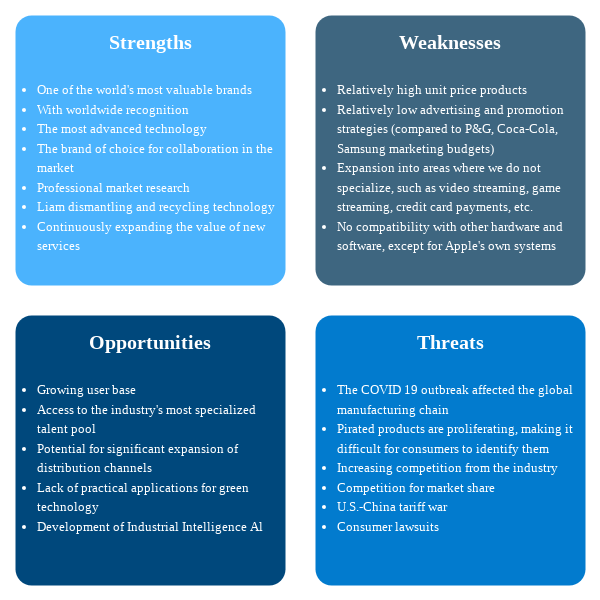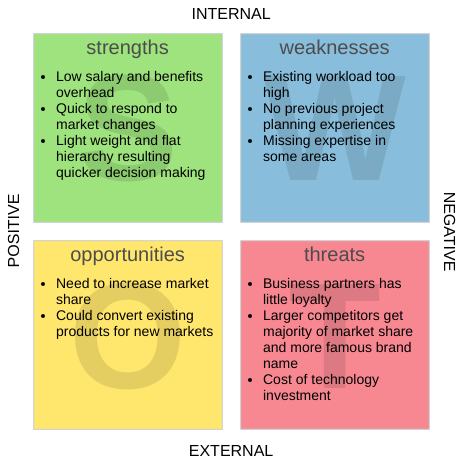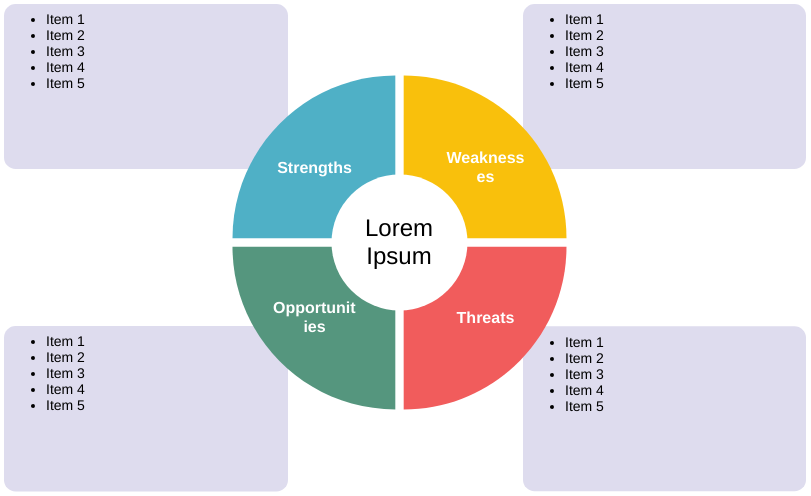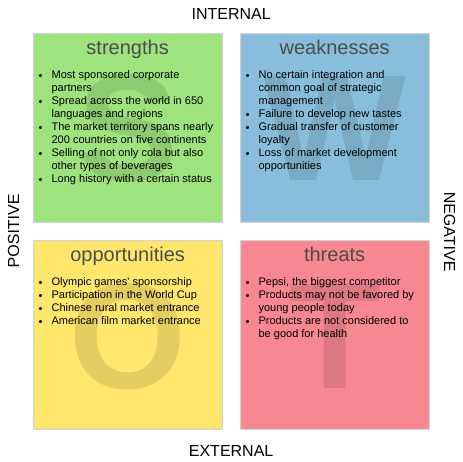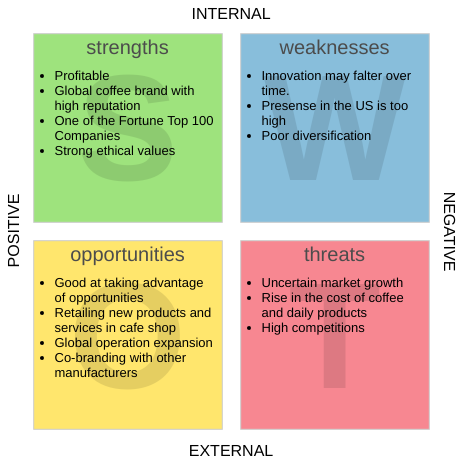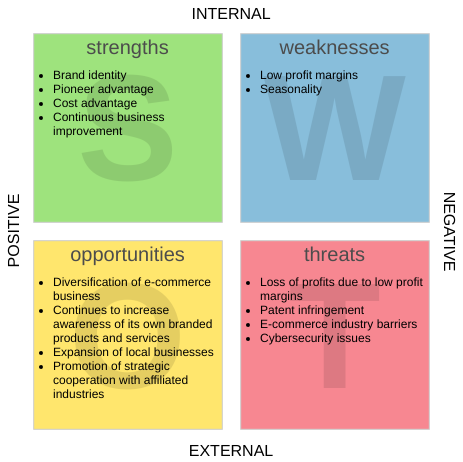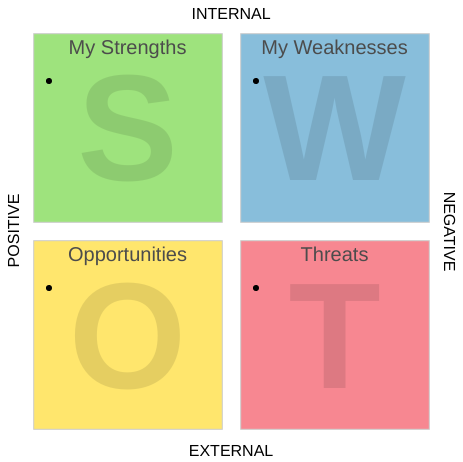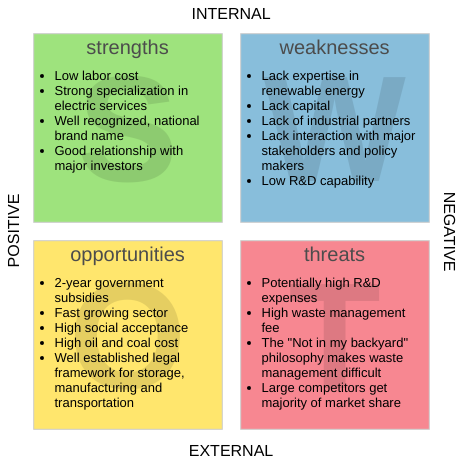Phân tích SWOT là gì?
phân tích SWOTlà phương pháp phân tích thị trường phổ biến nhất được sử dụng trong kinh doanh và học thuật để đánh giá các điểm mạnh và điểm yếu nội bộ của một công ty cũng như các cơ hội và mối đe dọa từ các đối thủ bên ngoài thông qua việc động não.
Phân tích SWOT đại diện cho Điểm mạnh, Điểm yếu, Cơ hội và Mối đe dọa. Khung phân tích này giúp các công ty đánh giá vị thế cạnh tranh của họ và xây dựng các kế hoạch chiến lược.
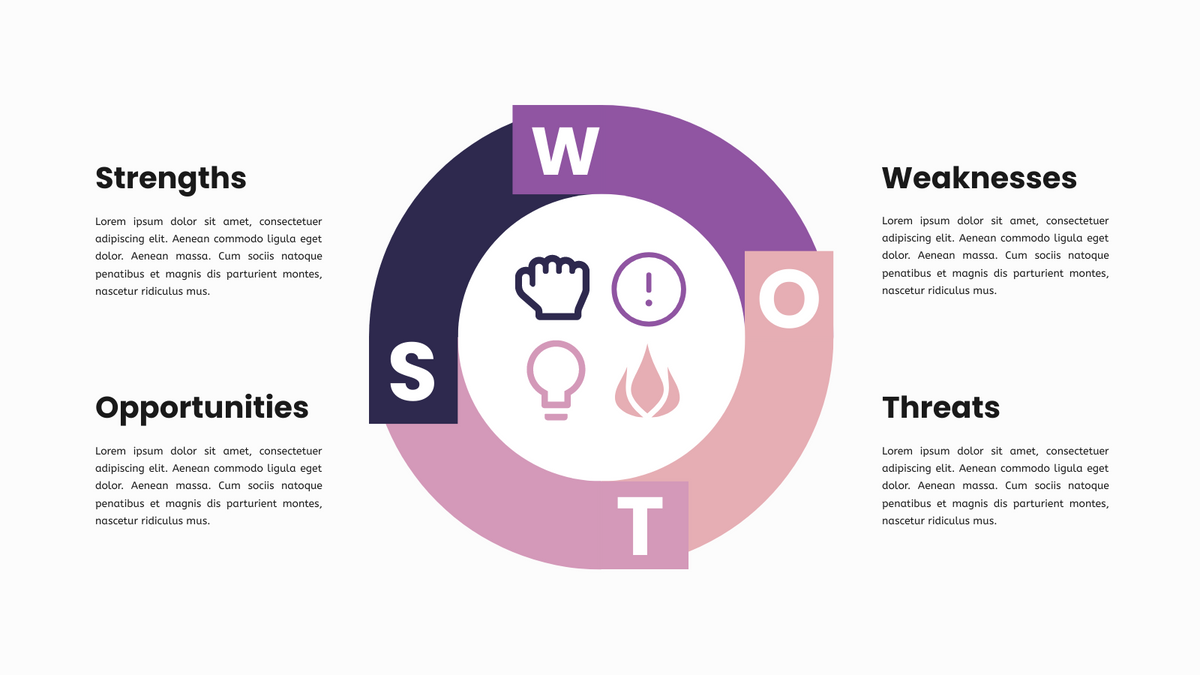
- Điểm mạnh: Những lĩnh vực mà một công ty xuất sắc, giúp phân biệt nó với các đối thủ cạnh tranh. Ví dụ bao gồm thương hiệu mạnh, cơ sở khách hàng trung thành, công nghệ độc đáo, v.v.
- Điểm yếu: Những gì ngăn cản một công ty hoạt động tốt nhất, đó là những lĩnh vực mà công ty cần phải củng cố. Ví dụ bao gồm danh tiếng thương hiệu yếu, mức nợ cao, chuỗi cung ứng không đầy đủ, vốn không đủ, v.v.
- Cơ hội: Các yếu tố bên ngoài có thể mang lại lợi thế cạnh tranh cho một công ty. Ví dụ, nếu một quốc gia công bố giảm thuế quan, các nhà sản xuất ô tô sẽ có thể xuất khẩu ô tô sang các thị trường mới và tăng doanh số bán hàng cũng như thị phần.
- Mối đe dọa: Đây là những yếu tố có khả năng gây hại cho một doanh nghiệp. Các mối đe dọa phổ biến bao gồm chi phí nguyên liệu thô tăng, nguồn lao động không đủ và sự cạnh tranh gia tăng.
Phân tích SWOT xuất phát từ đâu?
SWOTlà một phương pháp phân tích thị trường được đề xuất bởi Giáo sư Heinz Weihrich của Đại học San Francisco vào năm 1980. SWOT là một lưới bốn phần, trong đó các điểm mạnh, điểm yếu, cơ hội và mối đe dọa của công ty được tóm tắt và viết thành một cột, sau đó các kế hoạch hành động cụ thể được đề xuất cho kết quả phân tích SWOT.
Những hiểu biết SWOT cho các nhà quản lý
Các nhà quản lý có thể xây dựng dựa trên phân tích SWOT cơ bản bằng cách tập hợp nhân viên từ các phòng ban khác nhau, bao gồm bán hàng, dịch vụ khách hàng, tiếp thị và phát triển sản phẩm, để phát triển một báo cáo hiểu biết kinh doanh sâu sắc hơn.
Tuy nhiên, vì thế giới kinh doanh luôn thay đổi, tốt nhất là các nhà quản lý nên thực hiện một phân tích SWOT mới mỗi 6 đến 12 tháng để liên tục đánh giá lại hướng phát triển chiến lược nhằm đáp ứng với những thay đổi bên ngoài.
Phân tích SWOT: Coca-Cola
Điểm mạnh
- Nhận thức về thương hiệu:Coca-Cola là một trong những thương hiệu được công nhận rộng rãi nhất trên thế giới và đã phát triển một cơ sở khách hàng trung thành. Với thị phần lớn, công ty có nguồn tài chính rất mạnh và có khả năng thực hiện các sáng kiến tiếp thị lớn hoặc đổi mới sản phẩm để duy trì hoặc tăng trưởng thị phần.
- Mạng lưới chuỗi cung ứng:Coca-Cola cung cấp đồ uống cho hơn 200 quốc gia thông qua một mạng lưới chuỗi cung ứng mạnh mẽ gồm các nhà phân phối thuộc sở hữu/kiểm soát của công ty, các nhà đóng chai độc lập, các nhà bán buôn và bán lẻ. Mạng lưới này cũng cho phép Coca-Cola nhanh chóng giới thiệu các sản phẩm mới vào các thị trường khác nhau để chiếm lĩnh thị phần.
Điểm yếu
- Quản lý nước:Nước là thành phần chính trong tất cả các sản phẩm của Coca-Cola. Tuy nhiên, nhu cầu về nước vẫn tiếp tục tăng trên toàn cầu và nguồn nước đang trở nên ngày càng khan hiếm. Chất lượng tổng thể của các nguồn nước có sẵn có thể xấu đi, khiến Coca-Cola phải đối mặt với chi phí cao hơn và ảnh hưởng tiêu cực đến lợi nhuận.
- Biến động tỷ giá:Vì báo cáo tài chính hợp nhất của Coca-Cola được tính bằng đô la Mỹ, công ty phải chuyển đổi doanh thu, chi phí, tài sản và nợ phải trả sang đô la Mỹ. Một sự suy giảm đột ngột và đáng kể trong các đồng tiền của các nước đang phát triển hoặc thị trường mới nổi có thể ảnh hưởng tiêu cực đến lợi nhuận của công ty, cũng như tài sản của nó ở những thị trường đó.
Cơ hội
- Đa dạng hóa:Coca-Cola đã mua Keurig Green Mountain, một phần của Monster Beverage, nhà sản xuất đồ uống năng lượng, và năm ngoái (2018) đã mua Costa, một chuỗi cà phê của Anh (đọc thêm: Coca-Cola đối đầu với Starbucks, 5,1 tỷ đô la cho đối thủ Starbucks Costa). (Đọc thêm: Coca-Cola đối đầu với Starbucks trong một thỏa thuận 5,1 tỷ đô la để cạnh tranh với Costa, khi cuộc chiến cà phê bước vào một kỷ nguyên của những liên minh lớn) Coca-Cola có thể sử dụng những khoản đầu tư này để thâm nhập vào các thị trường đồ uống khác nhau và tiếp cận một cơ sở khách hàng rộng hơn.
- Mở rộng phạm vi:Ấn Độ và Trung Quốc, chẳng hạn, đang chứng kiến nhu cầu tăng cao về nước trái cây và cà phê, trong khi các nước đang phát triển đang phải đối mặt với tình trạng thiếu nước nghiêm trọng và sự gia tăng nhu cầu về nước đóng chai. Những xu hướng tiêu thụ đồ uống này có thể là một cơ hội cho Coca-Cola.
Mối đe dọa
- Lối sống lành mạnh đang gia tăng:Với ngày càng nhiều người tiêu dùng chuyển sang các sản phẩm tự nhiên và hữu cơ và trở nên nhận thức hơn về chế độ ăn uống và thể dục, sự chuyển mình văn hóa này dường như không có dấu hiệu giảm bớt. Cũng do xu hướng sống lành mạnh, một số chuyên gia đang kêu gọi loại bỏ thực phẩm và đồ uống có đường, mà họ cho rằng đặt công chúng vào nguy cơ cao về béo phì, tiểu đường và bệnh tim.
- Đối thủ gián tiếp:Trong khi các công ty như Starbucks hoặc Dunkin’ Brands Group không cạnh tranh trực tiếp với Coca-Cola, họ có thể đang làm giảm thị phần của Coca-Cola bằng cách cung cấp các lựa chọn lành mạnh hơn cho người tiêu dùng.
Phần mềm phân tích SWOT
Visual Paradigm Online là một công cụ biểu đồ hàng đầu. Trình chỉnh sửa phân tích SWOT của nó bao gồm một trình chỉnh sửa dữ liệu dựa trên danh sách trực quan cho phép bạn điền vào các biểu đồ SWOT một cách nhanh chóng và dễ dàng. Visual Paradigm Online cũng có một bộ sưu tập lớn các biểu đồ kinh doanh và kỹ thuật, cung cấp hàng trăm ví dụ và mẫu biểu đồ cho phép bạn nhanh chóng tạo ra các biểu đồ của riêng mình. Phiên bản miễn phí của Visual Paradigm Online có sẵn cho mục đích không thương mại và hỗ trợ UML, ERD và thiết kế biểu đồ tổ chức.
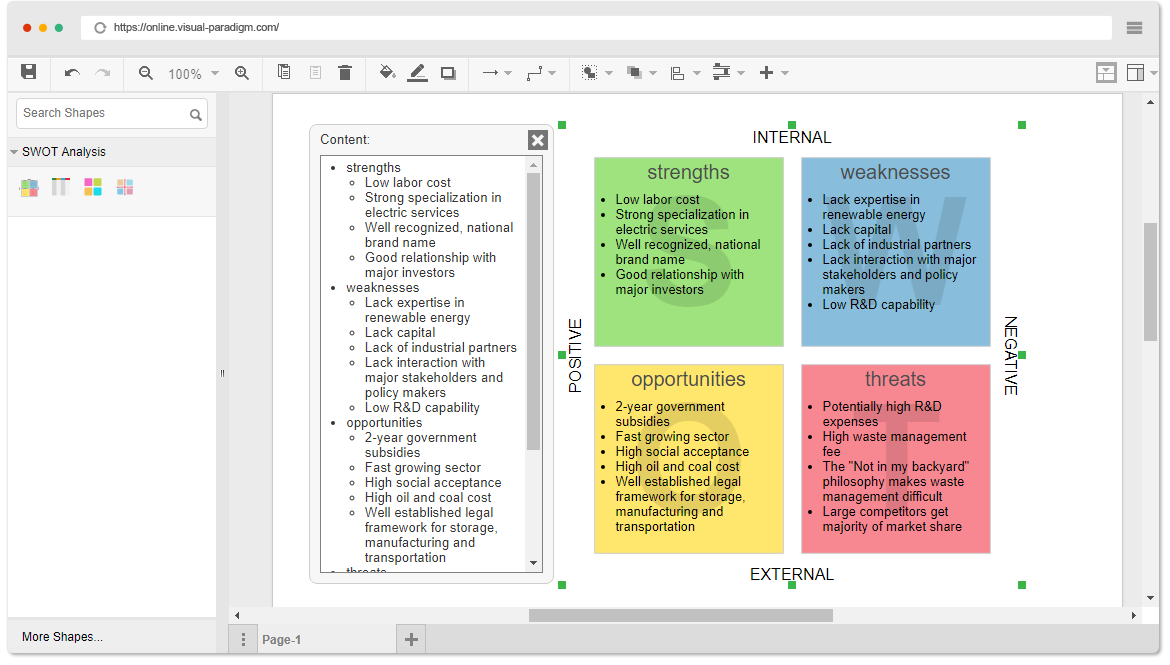
Liên kết liên quan
* Phân tích SWOT được hỗ trợ bởi công nghệ web của Visual Paradigm. Bạn có thể tạo nó cả trongVisual Paradigm DesktopvàVisual Paradigm Online.
thêm
Thêm ví dụ và mẫu SWOT
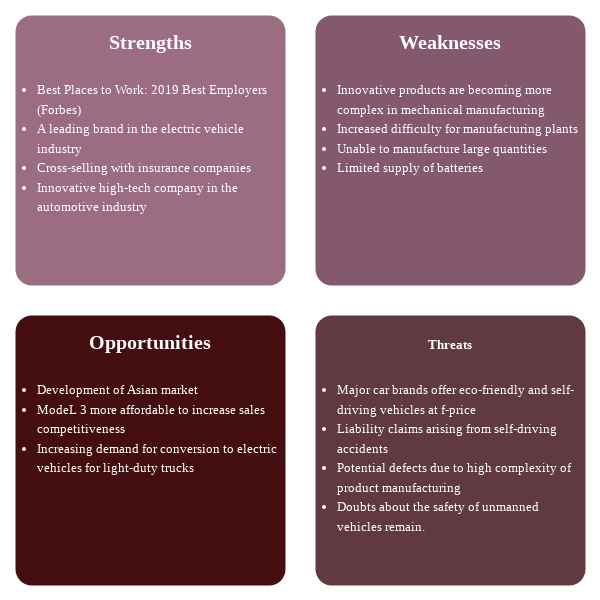
Khởi nghiệp doanh nghiệp nhỏ trên Internet
Mẫu phân tích SWOT (Hình lục giác)
This post is also available in Deutsch, English, Español, فارسی, Français, Bahasa Indonesia, 日本語, Polski, Portuguese, Ру́сский, 简体中文 and 繁體中文.














